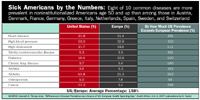Are We Less Healthy Than Europeans?
Pharmaceutical Executive
Americans take top spots in disease prevalence
A new study comparing the prevalence of different diseases in the United States and Europe has not received the media coverage it deserves. The paper by Kenneth Thorpe, David Howard, and Katya Galactionova, published online by Health Affairs (October 2, 2007), concluded that "disease prevalence rates...for 10 of the most costly conditions...for the noninstitutionalized population age 50 and older...are much higher in the United States than in these [10] European countries."

Sick Americans by the Numbers: Eight of 10 common diseases are more prevalent in noninstitutionalized Americans age 50 and up than among those in Austria, Denmark, France, Germany, Greece, Italy, Netherlands, Spain, Sweden, and Switzerland
This conclusion was based on Organization for Economic Co-operation and Development data (see chart, below). These findings are consistent with another piece of research published in Journal of the American Medical Association (May 3, 2006) by James Banks, Michael Marmot, Zoe Oldfield, and James Smith that compared both self-reported illnesses and biological markers of disease among non-Hispanic whites age 55 to 64 in England and the United States. They concluded that "based on self-reported illnesses and biological markers [my italics] of disease, US residents are much less healthy than their English counterparts and these differences exist at all points of the SES (socioeconomic status) distribution."
These dramatic findings trigger the obvious question: Why are the numbers so much higher here? One attractive hypothesis is that Americans are merely more likely to be diagnosed with diseases because of the more aggressive testing in this country.
However, this hypothesis could at best explain only part of the difference. The use of biological markers in the US/England study confirmed that these differences are real, not just based on different patterns of diagnosis. Furthermore, the fact that the United States has fallen in international rankings of life expectancy from No. 11 to No. 42 over 20 years strongly suggests that Americans really are less healthy than people in most other affluent countries.
Other factors mentioned by the authors are differences in obesity, lifestyles, health insurance, childhood experiences, and income inequality.
My favorite hypothesis—based on the work of Michael Marmot and others, but barely hinted at in these papers—is stress. Having lived and worked on both sides of the Atlantic, it would not surprise me if Americans were substantially more stressed than Europeans. Americans work longer hours, have fewer vacation days, have a weaker safety net, and have greater income inequality than Europeans. There is growing evidence that stress can weaken the immune system and increase the likelihood of many diseases.
It will probably take years to understand this issue. Meanwhile, both teams of researchers conclude that we need—guess what?—to do more research.
Humphrey Taylor is chairman of the Harris Poll, Harris Interactive. He can be reached at htaylor@harrisinteractive.com

Addressing Disparities in Psoriasis Trials: Takeda's Strategies for Inclusivity in Clinical Research
April 14th 2025LaShell Robinson, Head of Global Feasibility and Trial Equity at Takeda, speaks about the company's strategies to engage patients in underrepresented populations in its phase III psoriasis trials.
Beyond the Prescription: Pharma's Role in Digital Health Conversations
April 1st 2025Join us for an insightful conversation with Jennifer Harakal, Head of Regulatory Affairs at Canopy Life Sciences, as we unpack the evolving intersection of social media and healthcare decisions. Discover how pharmaceutical companies can navigate regulatory challenges while meaningfully engaging with consumers in digital spaces. Jennifer shares expert strategies for responsible marketing, working with influencers, and creating educational content that bridges the gap between patients and healthcare providers. A must-listen for pharma marketers looking to build trust and compliance in today's social media landscape.